BlazBlue: The Calamity Trigger – First Look
by Samuel
|
I first became aware of BlazBlue from the Xbox 360 ‘Inside Xbox’ dashboard blade, nearly a year ago. An enthused and obviously better informed arcade fighter fan than I wanted to know when we could expect to see it here in the UK and Europe, when it had already been released in Japan and America to not inconsiderable praise from genre devotees and games critics. Normally this wouldn’t concern me too much, after all, it wasn’t a game I was familiar with at the time, and lots of titles don’t make it across the pond to us. That’s what import collectors exist for.
On this occasion though I found myself suddenly very interested, and annoyed at the stock “we know nothing about plans to publish in Europe” response to the question. The brief clips of the gameplay, and the mention of BlazBlue having been developed by ARC System Works, the people responsible for the Guilty Gear franchise, caught my attention enough to want to go away and look it up online. This in turn led to my discovering that it was a true traditional 2D arcade fighter, based on the same Taito Type X2 engine that powers ARC’s underappreciated Battle Fantasia, and Capcom’s Street Fighter IV and Super Street Fighter IV. Being fully aware of how well the engine performed for Street Fighter, combined with more video clips of action from the arcade version of BlazBlue sold me on the game without ever actually getting my hands on it. Considering how cagey I am about playing demos before shelling out money for games, on account of having been burned in the past by heavily praised titles that seemed somehow lacking on delivery, it would be fair to say that the little I had seen was personally very impressive. There was just one problem. The fact that nobody had been contracted to publish the game in Europe.
Fortunately, Zen United have finally brought the Xbox 360 and PS3 console ports of BlazBlue to the UK, albeit 10 months after the rest of the world, who are currently 2 months away from receiving the sequel; BlazBlue: Continuum Shift. There are also a Windows PC and a PSP version of the game available overseas, and their releases on these shores, along with any future release of the sequel, likely depend heavily on how well the Xbox and Playstation versions sell. In this lies the rub, however, as unless you follow news about what’s currently hot in Japanese arcades very closely, or happen to stumble across the game by accident as I did, you’re unlikely ever to hear of it. The marketing hype and advertising for BlazBlue are practically non-existent, with the only real exposure of the game’s European release being that it has shown up at a considerably reduced price on online shops; I managed to pick up the Limited Edition, with a 100 page art book and a bonus DVD, at preorder for much less than the usual cost of a standard Xbox 360 release.
Anyone who has played an arcade fighting game before will recognise BlazBlue’s basic gameplay, or at least they will think that they recognise it (more on that later). It’s the standard arrangement of two combatants fighting in two dimensions from opposing sides of the screen, with the victor being declared as the player as either left standing, or with the most health points intact after the round, or rebel, clock expires. There are 12 playable characters in total, each with their own unique styles of combat, but all with the same basic control configuration of a weak, medium, heavy, and drive attack. Despite having a comparatively small character roster compared to other fighting games, most of the usual Japanese game and anime archetypes are covered in BlazBlue; Iron Tager is the massive but slow powerhouse, Taokaka is the cat girl, Ragna is the misunderstood anti-hero with the spiky hair and massive sword, v-13 is the overly emotional and violently unstable android girl who’s falling in love and trying to destroy the planet in the process, Jin is the evil pretty boy with a big ego and hidden past with the hero, and so on and so forth.
Despite the very traditional presentation, BlazBlue is actually a very different kind of fighting game, in terms of how it plays and feels. Initial playthroughs in the single player arcade mode and story mode left me somewhat shocked, at how dissatisfying they were. Enough so to make me wonder if perhaps I hadn’t made a terrible mistake and fallen for the accolades the game had received in arcades abroad. The characters, and their various fighting styles and drive techniques, seem at first to be hopelessly unbalanced. It is very simple to win certain matches simply by using a character or move that takes advantage of some major flaw or weakness in your opponent, whilst in others you don’t stand a chance against the AI as it does the same to you with unrelenting precision. Every match seemed to end in seconds, regardless of the outcome, with more of my time being spent looking at loading screens and cutscenes than playing the game itself.
With regards to the story mode, which, as is common in the genre, wasn’t originally a part of the arcade game and later added to expand the console experience and prolong gameplay… well. What can I say. As a gamer I look to games generally that have superior story writing and more than merely visually interesting characters. I’ve come not to expect this from fighting games, however, and other critics had raised my hopes with tales of a fulfilling and comparatively rich set of character stories based around a single plot through-line. That plot is expressed right from the start in a clumsily animated, initially confusing and lengthy cutscene featuring some decidedly dodgy voice acting (whoever thought also that not having any of the character’s mouths move was a way of mitigating lip sync issues between languages was dead wrong; it is much more distracting and unnatural). The game itself seems to realise just how mind-numbingly tedious this exposition is, as I was surprised to see an Xbox achievement pop up after somehow staying awake through it, congratulating me on not skipping the whole thing after the first few seconds.
That feeling of dissatisfaction continues as you play through each character’s individual stories. Each chapter has about 5 minutes of exposition, two minutes of loading screens, and then 10 to 15 seconds of actual fighting. Only one or two of the characters have genuinely compelling stories anyway, and those too are ruined by more piss-poor voice acting and stunted animation. Very occasionally you are given a choice about how to proceed, but mostly the stories are very linear, and there’s no apprehension of danger or risk, as losing a match simply results in a different cutscene where instead of celebrating victory before moving on, your character cries about being duffed up before moving on.
It was therefore with a certain bewilderment and sense of having been deceived that I moved on from the single player modes to the multiplayer, which as with Street Fighter IV and other modern fighting games includes both the traditional split-screen play between two people in the same room, and online play over Live. It was in my first ranked player match over Live that I had my second big surprise. Because suddenly the game came to life and blew me away.
I can’t stress enough how the single and multiplayer modes of BlazBlue are totally different games. The unbalanced characters and fighting styles suddenly make sense when you come up against a skilled human opponent. They force you to use advanced tactics and your imagination in dealing with the other player, and button-bashing the same attack over and over no longer works at all. You need to get creative in order to defend against characters that have an advantage over yours, and to in turn force your opponent into making the mistake that opens them up to your pressing home your advantages. You can’t take what works when playing as one character and expect it to work when playing as another, unlike in other fighting games such as Street Fighter, where skill at handling one character translates across most of the others to some extent. Matches become near-run things, dependent on the skill, timing, and experience of the respective players, and can last over a minute per round instead of the all too brief slaughterfests of the single player modes.
Technically the online multiplayer is solid as a rock too. I didn’t once encounter the slightest hint of lag, which is usually mortal in these kinds of game, no matter how good they are. I couldn’t tell the difference between the online and split-screen multiplayer matches other than the fact of whether or not the shouted swear-words or crows of jubilation were coming from some hyperactive German teenager (everyone else playing this online seems to be either German or Austrian, though I did play against a solitary Japanese player) over my headset or from my sister’s fiancé on the couch beside me. And as more regular members of the GamingLives community are aware, I live out in the sticks with a less than reliable internet connection at times, making it all the more impressive.
It was only after playing the multiplayer modes that I realised the problem in the single player is that the computer AI simply isn’t up to the task. It lacks the imagination or determination of a human player to make up for character shortcomings, and it’s too efficient and can’t be forced into errors when it has the advantage. This absolutely ruins the single player game, and it’s a shame, as BlazBlue is possibly the best fighting game currently on the 360, with the caveat of when played against a human opponent. Unfortunately, other games like Street Fighter are still a lot of fun when nobody else is online, or you’re a Billy no mates, and that really hurts BlazBlue unnecessarily.
Visually BlazBlue is stunning. The arena backgrounds are all rendered in 3D, despite the 2D nature of the gameplay and character art, similar to Marvel vs. Capcom 2, Guilty Gear XX and Capcom vs. SNK 2 EO. The character art itself is also graphically impressive despite the simplicity you’d imagine from basic 2D sprites; each frame has been hand drawn in HD resolution, and the character designs, whilst clichéd rehashes of well known anime tropes, are well executed and fun. Each character comes with various colour palettes unlocked on the disk, and a special Unlimited version; both features which were missing from the arcade version of the game, and only available to console players in Japan and the USA as premium DLC; it’s a nice little gesture to make up for the long delay in getting the game to European gamers, and one I appreciated.
The sound design can be a bit hit and miss. The music is generally excellent, apart from suffering the standard God awful J-pop theme song. And sound effects in battle seem to fit in well too. Unfortunately, the voice acting is complete shite, despite having some well known seiyus and American voice actors on both the Japanese and English dubs. The only character whose voice acting didn’t make me want to insert hot needles into my brain via my ears was Iron Tager, voiced in the English version by Jamieson Price (you might recognise his booming tones from Castlevania: Lament of Innocence, Disgaea: Hour of Darkness, or Tales of Vesperia; anime buffs may also know him from minor roles in Akira, Naruto, or Cowboy Bebop, to mention just a few). Which was fortunate for me personally, as Tager is the character I gravitated towards favouring most when playing the game due to my style of play. It’s not really an issue in fights, as voice work is limited to a few shouted catchphrases and the usual parade of grunts and screams, but it can make the cutscenes in the single player modes virtually unbearable. Both Japanese and English voices are available to choose between in the game options from the start, yet, unusually in these things, both are equally terrible.
Pros- • Gorgeous in-game artwork and design.
• Genuinely unique fighting techniques for each character.
• A more tactical approach to 2D arcade fighting games.
• Lag? What lag?
• Programmed specifically to be compatible with the MadCatz Street Fighter IV and Hori arcade fightsticks.
• Despite the above, actually works really well on a standard control pad too.
- • Atrocious AI fatally ruins the single player modes.
• Unbalanced characters demand high standards of players involved.
• Lazily animated cutscene videos.
• Typically convoluted and unsatisfying story mode.
• That theme song.
• Voice acting that must have been phoned in, or the people involved should be very ashamed, because my ears are bleeding! Bleeding!
BlazBlue is two different games rolled into one. On the one hand you have a single player experience that veers wildly between mediocre and bloody awful, making it virtually unplayable, if you can survive past the cutscenes and story exposition. On the other hand, you have what is probably the best online fighting game I’ve played, and I’ve got a lot of arcade fighter console ports on the shelves, and got very depressed when the last local arcade was closed some years back.
For the multiplayer alone, this game is worth a look. But really; don’t even load the single player modes up out of curiosity, because you’ll wind up regretting it. Whether or not the multiplayer does enough to get people to stop playing Street Fighter IV, or will be enough to prevent those that do then migrating again in a month’s time with the UK release of Super Street Fighter IV, I don’t know. But the online play genuinely deserves a chance, as if you take the time to let it grow on you and expel your assumptions based on other fighting games, it’s probably got more depth, thought, and technical clout behind it than anything else the genre currently offers.
BlazBlue is a very flawed, frustrating and even broken game in some ways. But in others, it’s simply magnificent.
Last five articles by Samuel
- Wargame: European Escalation - Preview
- Sony Conference - GamesCom 2011
- Gotham City Impostors Hands-On Preview
- WipEout 2048 - Hands-On Preview
- City to City - Travelling to Cologne via London with Gerry Rafferty















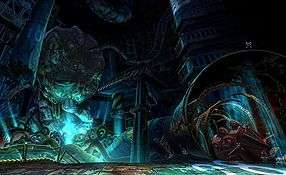
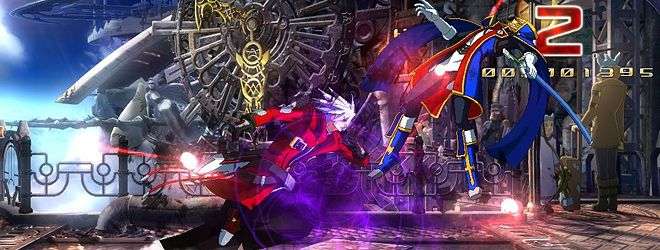
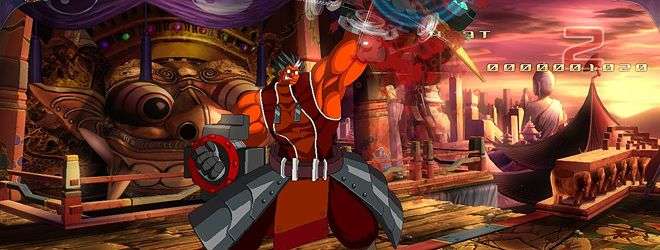
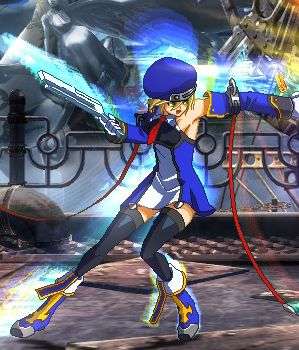
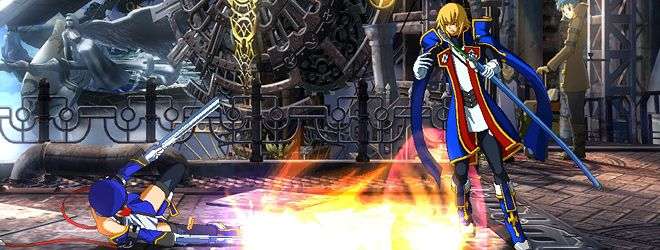
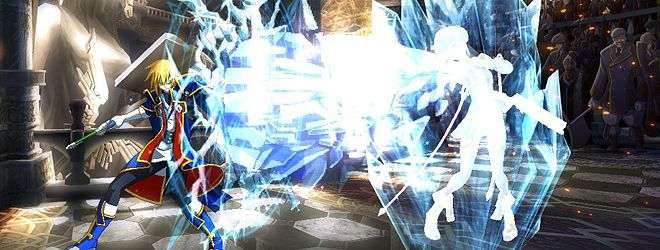





Nice review Preach. This was one of those titles that I keep spotting on sites and shelves and not having the thought to actually look and see what it was.
For me, fighting games make great Sofa games. I think it’s nice to be able to rub it in when you beat your friends and it’s always a giggle. I think it’s great that the genre hasn’t died out but I can’t really abide with what feels like half a game to me. Besides fighting the AI and fighting online, theres nothing left to do. I’ve a lot of respect for gamers that have the patience to master this art, but it’s not for me, I need moar! MOAR!